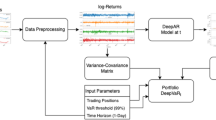Abstract.
This paper examines a new approach for credit risk optimization. The model is based on the Conditional Value-at-Risk (CVaR) risk measure, the expected loss exceeding Value-at-Risk. CVaR is also known as Mean Excess, Mean Shortfall, or Tail VaR. This model can simultaneously adjust all positions in a portfolio of financial instruments in order to minimize CVaR subject to trading and return constraints. The credit risk distribution is generated by Monte Carlo simulations and the optimization problem is solved effectively by linear programming. The algorithm is very efficient; it can handle hundreds of instruments and thousands of scenarios in reasonable computer time. The approach is demonstrated with a portfolio of emerging market bonds.
Similar content being viewed by others
Author information
Authors and Affiliations
Additional information
Received: November 1, 1999 / Accepted: October 1, 2000¶Published online December 15, 2000
Rights and permissions
About this article
Cite this article
Andersson, F., Mausser, H., Rosen, D. et al. Credit risk optimization with Conditional Value-at-Risk criterion. Math. Program. 89, 273–291 (2001). https://doi.org/10.1007/PL00011399
Issue Date:
DOI: https://doi.org/10.1007/PL00011399




